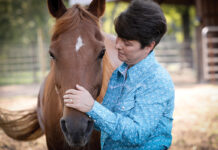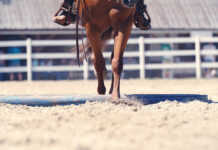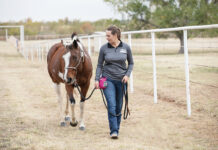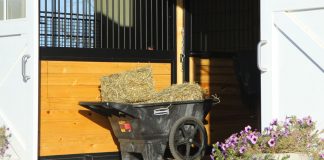
Accordingly, daily vigilance by caretakers is crucial to successful full-time turnout.
 Herd Compatibility
Herd Compatibility
Horses need to be introduced to one another gradually and should be monitored whenever a change occurs in the group. Their hierarchical social structure resembles a game of musical chairs each time a new horse is introduced, a herd member leaves, or an individual’s status changes. A relatively mild-mannered horse can become more assertive as the chain of command is altered when a dominant horse leaves; some horses move up in rank and others are demoted. Unfortunately, new herd members are sometimes victimized by others so relentlessly that they must be removed to prevent possible injury.
Experienced barn managers avoid problems at the outset by grouping horses with similar personalities and acquainting those unfamiliar with each other over the fence in neighboring fields, or in adjacent stalls. Always take a few precautions before adding to an established herd, rather than opening the field gate and hoping for the best.
Grouping horses in pastures by gender, age and temperament is the best method to ensure compatibility. There are a few types of horses that do not belong in herds, such as stallions, geldings that act studdish, or horses that are non-assertive and are continually harassed—they all require separate paddocks.

Pasture Considerations
Once you have a compatible herd, one of your biggest management issues will be how to provide these horses with the best quality forage during the growing season. If you put too many horses out on too little space and allow them to eat to their heart’s content, your pasture will become sparse. Because horses have no concept of saving food for later, the only way to salvage forage on limited space is to rotate pastures after grass is grazed down to a 3-inch height. Step-in posts make it easy to place temporary electric fence in different areas for rotation.
Another crucial requirement for turnout is having clean water available at all times. Even if you have a pond or stream on your property, you should use an alternative source of water for environmental and quality reasons. Many farms have stock tanks that someone must clean and refill frequently. Another option is to install automatic waterers. Over time, the benefits will offset the initial cost, especially in cold climates where stock tank heating elements use a lot of electricity.
“While the initial cost to install an automatic waterer can be expensive, customers who currently heat stock tanks during the winter will find that installing a heated, energy-efficient waterer will pay for itself by the end of the first winter,” says Ruth Peterson, marketing manager for Ritchie Industries, one of several well-known manufacturers of automatic waterers. “A stock tank that requires a 1500-watt heater during the winter can cost upwards of $100 or more per month, compared to $25 to $35 per year for an automatic waterer.”
Other benefits of automatic watering systems are convenience, the ease of upkeep, a continuous supply of clean water and minimal water waste. However, automatic water systems do have a few drawbacks: they can promote a false sense of security, make it impossible to determine how much water your horses consume, develop mechanical problems, and can’t be moved around.

Seasonal Issues
While leaving horses outdoors in all but the worst weather is advantageous in many ways, you should always consider the realities of their exposure to certain conditions. Every season has aspects that are fraught with challenges. Lush spring grass can cause horses to develop laminitis if owners misjudge grazing limits. As the days grow hotter, the summer sun—essential for growing grass and curing hay—can wreak havoc on a pink nose.
Hot, humid weather also spawns afternoon thunderstorms. Horses will congregate with their hindquarters to the wind during a downpour while lightning strikes all around them, putting them at risk of being struck.
Beautiful summer days are also routinely ruined by hordes of biting insects. They can drive an otherwise sedate and lazy horse to a frenzied gallop for shelter.
Manufacturers have come to the rescue with an array of products to help you alleviate some of the misery. Specialized insecticide sprays, lightweight mesh fly sheets, fly masks (some with ear covers) and mesh leg boots are all designed to foil even the most persistent pasture pests.
A major drawback to outdoor horse clothing is its uncanny ability to twist, droop, become a toy for herd members, accumulate dirt, and get hung up on protruding objects. Horse clothing creates even more reasons for daily observation. However, while adjusting protective gear is a nuisance, the function of the coverup justifies the hassle. Insects cause an abundance of health problems, such as allergic reactions to bites, West Nile virus and Lyme disease, equine encephalitis, infection of open wounds and other serious complications.
Most horse owners believe fall is the perfect season for riding: the bugs are gone, the ground is firm, and the air is crisp and cool. This may be true on a trail ride, but make sure that your horses aren’t feasting on colorful leaves and crunchy acorns in their pasture—some leaves are toxic and a belly full of acorns is a recipe for colic.
Even fall grass can be deceptive. You may associate colic and laminitis with lush, spring grass, but the sugar content of some plants spikes in sunny weather with colder temperatures (below 40 degrees Fahrenheit). Sugar content is typically lowest from 3 a.m. to 10 a.m. because the plant consumes it during the night for growth and hasn’t yet synthesized more from the sunlight. Turning your horse out earlier in the day is one precautionary measure; another is to take as much care when turning out a new horse—or one that has previously foundered—in the fall as you do in the spring.
Winter conditions can also be perilous because of icy surfaces, which can turn a pasture into a skating rink and increase the chances of horses and humans incurring serious injuries.
To Groom or Not
The grooming needs of pastured horses are minimal but should not be ignored completely. You still need to get up close and personal with your horse regularly rather than trying to make health and well-being assessments from afar. From a distance, you can’t see thrush, cuts or small puncture wounds, pluck ticks from ears, or scrape off bot fly eggs. Furthermore, if you neglect weed control in your pasture, you’ll have a plethora of burrs to remove from your horse’s mane and tail.
If your horse grows an adequate winter coat, you can feel less guilty during those fuzzy months if you aren’t quite as diligent about daily grooming, since natural oils protect the skin from getting too dry. If you blanket your horse, you should check his skin and coat condition every day for a buildup of scurf or the appearance of chafed areas that can become sore and infected. You should also readjust the blanket each day.
Avoid Pasture Nightmares
Most owners have some anxiety about turnout because so many horses are accident-prone enough to step into the one gopher hole in a 100-acre field, or are notorious escape artists who can find any gap in the fence. Obviously we can’t bubble wrap our horses (although many of us would like to), but we can avoid some man-made problems.
Gate and fence checks should become second-nature for everyone on your property, especially those leading horses into or out of a pasture. A nighttime escape is probably one of an owner’s worst fears. You should have a list of your neighbors’ telephone numbers posted in the barn so you can alert (or recruit) them in the event of a search. One solace for frantic owners is that horses see much better in the dark than most of us realize and have a good sense of direction; they often return on their own before they can be located.
A nighttime incident is one of the reasons for the debate about haltering pastured horses. Loose horses without halters can be practically impossible to catch, yet halters can cause real injuries if they are not at least partially made of leather so they can break away when hung up. Halters made entirely of nylon will not break if caught, and a struggling horse can end up injured or with a broken neck if an accident occurs.
Another concern about pastured horses is that non-horse people may cause problems by interacting with them when you aren’t present. They might unknowingly feed something to your horses that could be harmful. For example, most people are unaware that grass clippings, seemingly a tasty treat for horses, can harm them. Make sure landscape personnel and/or family members do not toss piles of freshly cut grass over the fence to your horses. Children are especially attracted to a field of horses and are usually clueless about hot wire or the danger inherent in crawling under a fence and offering treats to a group of 1,000-pound eating machines all competing for the first bite. It is better to discourage everyone from interacting with your horses unless they have your permission.
A few less common but equally important considerations when your horses live outdoors are horse thieves and feral predators. Nice horses can be quickly sold for a profit with no paper trail, so gates should be chained and padlocked at night, particularly if near a road where curious eyes can see into the farm.
Four-footed predators can be abundant in horse country. In areas where wolves and cougars hunt, horses are fair game. This type of rare incident cannot be anticipated; however, most pasture mishaps can be avoided with careful and consistent management.
By allowing your horses to live outdoors, you’ll have fewer barn chores, a healthier and happier herd, and the satisfaction of knowing they live in a more natural environment for their species.
Further Reading
The Stresses of Easy Living
Pasture Safety Checklist
Pasture Maintenance
Louann Chaudier and her husband live on Restless Spirit Farm in southern Wisconsin with two Quarter Horses, two wallabies, three barn cats and a Golden Retriever.
This article originally appeared in the Augsut 2009 issue of Horse Illustrated. Click here to subscribe.





